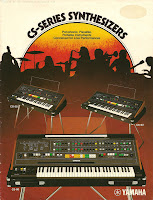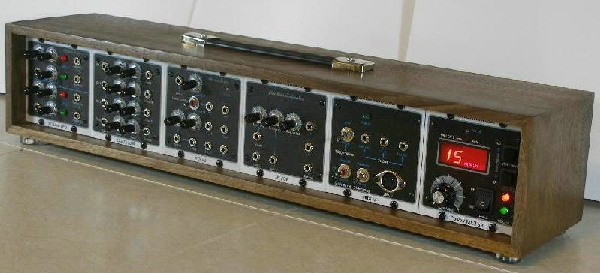Yamaha GX-1 "The 'Most' Yamaha goes to Mickie" 1-page advertisement from page 17 in International Musician and Recording World January (UK) 1978.
I'm a little embarrassed - for two reasons.
The first is a simple mistake - I almost overlooked this GX-1 advertisement because my eye's wouldn't leave a certain ad that sat across from it on the opposite page.
I swear that thing was looking right at me, deep into the recesses of my mind, pondering and judging my darkest secrets. It's like I was hypnotized by that giant mouse.
Okay - obligatory Halloween content finished.
The second reason I'm embarrassed is that I really had no clue who "Mickie" was. Which meant that the whole title thing - "The 'Most' Yamaha goes to Mickie" - was also lost on me. Part of the problem was that extra space between "Mickie" and ""Most" in the first line of the ad-copy. My mind wouldn't put the two words together in my brain and I thought maybe there was a word missing somewhere. I had to ask my GF if maybe the ad was referring to Mick Jagger. Seriously. I had no clue.
But when I finally did figure it all out (thanks Wikipedia!) everything else fell into place. Big producer... Rak Studios in London... Herman's Hermits... I learned a lot this weekend :)
If you recall from my last CS-80 blog post, Yamaha didn't seem to promote the CS-80 through advertisements in International Musician. And it looks like we now know part of the reason. They were spending at least a little of their advertising budget on this advertisement, while (intentionally or unintentionally) letting earned media promotion do it's thing for the CS-80.
Looking closer at this GX-1 ad, its kind of an anomaly. Yamaha usually wasn't one to "pull an ARP" by name-dropping so extensively in an ad. I'm not saying they never did it, but if I look at other Yamaha ads I've posted, usually they relied on throwing out a few technical terms and focusing on the reader as the musician.
But, in this case, Yamaha does the name-dropping job proud by using the Trifecta of "important music business stars" - Mickie Most, Stevie Wonder and, of course, Keith Emerson.
Although Stevie Wonder coined the term "Dream Machine" in reference to the GX-1, to me he will always be associated with samplers (probably just me showing my age group). I would thus argue that from my point of view, Keith Emerson was usually associated more closely with the GX-1 over on this side of the pond. And you don't have to look far for examples - like that awesome photo in the book Vintage Synthesizers of Keith playing a GX-1 while "ignoring" his Moog modular and Hammond C-3 in a Montreal stadium.
Keith also had a column in Keyboard Magazine called "Inside Tracks" where he answered readers' questions on keyboard technique, film scoring, recording projects and other musical topics. Unsurprisingly, a question about the GX-1 makes an appearance in the first run of the column found in the May 1983 issue.
Q: "Did you use the Yamaha GX-1 on 'Honky'"?It is not just the name-dropping references that make this such a great ad to me. The instrument is gorgeous and even this classic crappy black and white photo proves it. A friend has used the term "rocket body" to describe two things in life - p0rn stars and synthesizers. And the GX-1 probably fits nicely into both of those categories.
A: "No I couldn't get the GX-1 into Nassau, where the album was recorded. The island would hae sunk! It takes about eight people to lift the thing, and it was bad enough trying to get any other stuff into Nassau, let alone trying to get it out. So there's no GX-1 on Honky."
But it is that third paragraph of ad-copy that really puts this ad into perspective.
"The Yamaha GXI is the test bed of Yamaha Technology. Spin offs from this project have been utilized in the new ranges of Yamaha home organs and professional musical instruments."So, this isn't so much an ad for the Yamaha GX-1, but an ad for *all* Yamaha instruments. No one is expected to spend 40,000 pounds on an instrument after reading this ad. But I bet a few musicians thought about buying a few of the less expensive organs and synths, and maybe even a CS-80 or two, after reading about the trickle-down effect of GX-1 technology.
Lucky for me, I'm now in 2011and have friends of the blog like FlameTopFred and Micke to help guide me through synth-tech connections like those of the GX-1/CS-80/E-70. There is also that thing called the Internet - and a quick Google search (Web and images) brings up a wealth of information, including the well-written Wikipage article. Great tech information, as well as other fun facts such as finding out that Aphex Twin (Richard D James) acquired Mickie Most's GX-1. Also check out Gordon Reid's two-part series on the GX-1 found in the February 2000 and March 2000 issues of Sound On Sound. You will learn more than you ever wanted - including info about those speakers behind the machine in the photo. Digging a little deeper into search results is well worth the effort.
Making a huge buying decision without the Internet seems frightening to me now. I'm guessing name-dropping ads like this one might have been the tipping point for many of my purchases back in 1978 - more so if I had known who Mickie Most was... :)
But in the end, the biggest name-drop of all in this ad isn't Mickie - or Stevie or Keith
It is the GX-1 itself. Nice work Yamaha.

























